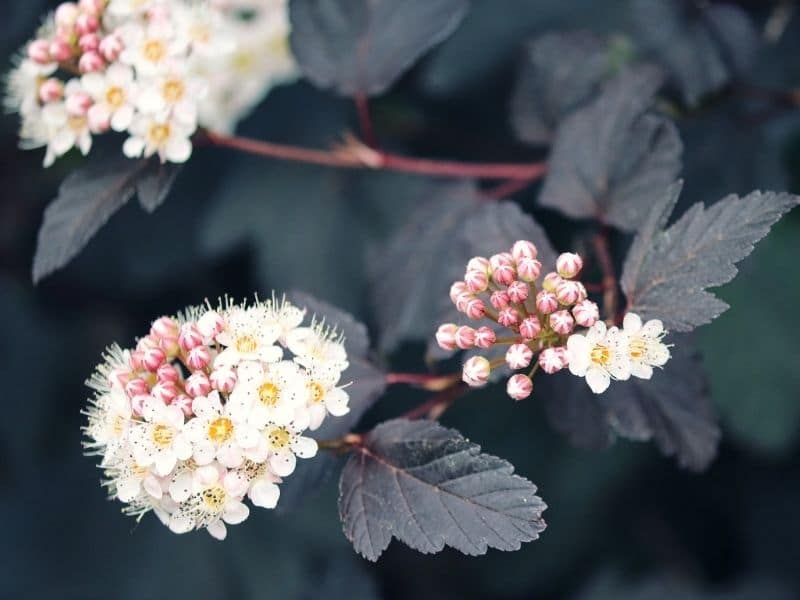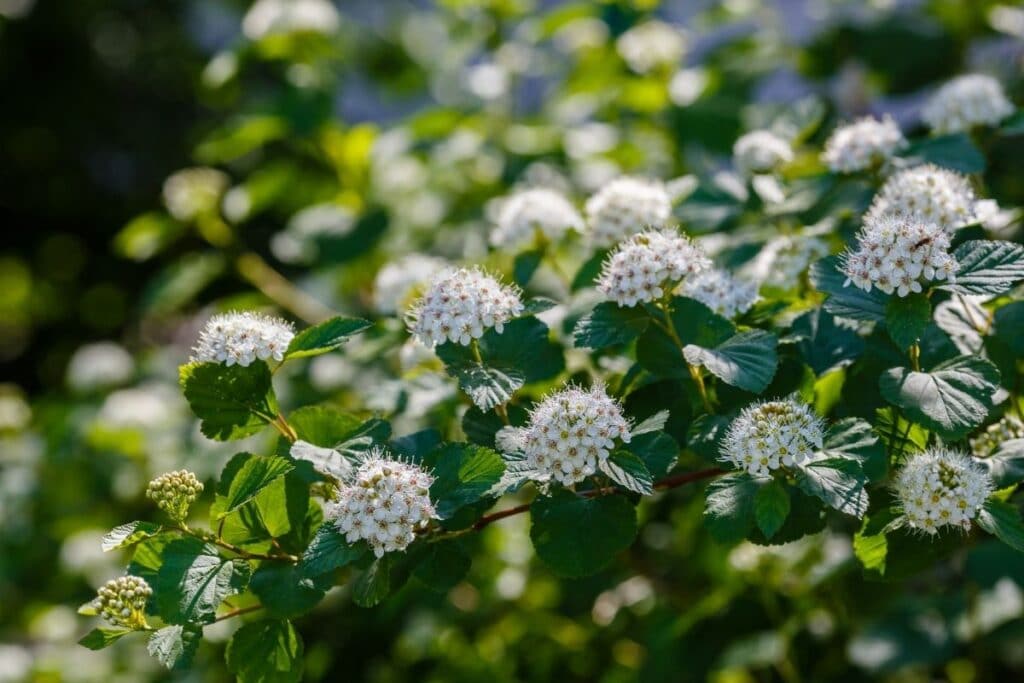Ninebark, Physocarpus opulifolius, is a wonderful native shrub that provides year-round interest, even though it is deciduous. This low-maintenance plant is incredibly cold hardy which makes it a great plant for cold northern gardens all the way down to zone 2.
Read on to learn more about growing and caring for this versatile shrub.
What Is A Ninebark Shrub?
Ninebark is a deciduous shrub of the Rosaceae family. This plant takes its interesting common name for its bark, which in the case of mature specimens, peels off in strips.
Ninebark is an upright arching shrub that grows up to about 10 feet (3 m) tall and nearly as wide. However, the size of the plant does vary greatly according to the variety/ cultivar and growing conditions.
This plant is native to the eastern and central regions of North America where it occurs in a variety of different habitats, including along riverbanks, in marshy areas, as well as in rocky areas, and more open habitats.
The dark foliage consists of alternately arranged leaves that measure 2 to 4 inches (5 to 10 cm) long. In most specimens, the leaves are most often 3 lobed, although some leaves have as many as 7 lobes. This shape, along with the leaves toothed margin, gives this plant a rather coarse texture.
In nature, wild ninebark plants have green leaves. In the horticultural trade, however, plants have been developed with a wide range of fantastic leaf colors, ranging from dark purple to orange, yellow, and green.
The leaf color also often varies as the season’s change, although these plants don’t show particularly good fall color.
The plant gets its name for its exfoliating bark which tears off, showing different shades of cinnamon/ reddish-brown below.
This is most pronounced in older stems and creates an interesting and attractive effect that is best appreciated when the plants are bare in the cold winter months. Young stems are smooth and flexible with a light color.

Ninebark Varieties and Cultivars
‘Summer Wine’ is a fantastic cultivar with deep purple to black foliage and light pink flowers. These plants grow to about 8 feet (2.4) tall and wide and grow best in zones 3 to 7.
‘Little Devil’ is a compact form that needs a lot less space than most forms. These plants grow to about 4 feet (1.2 m) tall and wide and have reddish-purple foliage.
‘Darts Gold’ is another compact variety that grows to about 5 feet (1.5 m) tall and equally wide. These plants have yellow to chartreuse leaves and produce white flowers with just a hint of pink.
‘Amber Jubilee’ has warm, golden orange new growth that matures green. This cultivar is hardy to zone 2 and grows to about 6 feet (1.8 m) tall.
Ninebark Flowers
Ninebark bushes are well-loved for their showy floral display in the late spring and early summer. The individual white or pink blooms are rather small, each having 5 petals and many stamens.
Fortunately, they occur in beautiful flattened flowerheads known as corymbs. These clusters measure up to a little over 2 inches (5 cm) across.
The fruits produced after flowering are another attractive feature of the ninebark shrub. Each flower in the cluster becomes an inflated capsule, known as a follicle, with a deep red to brown color. They can be a little bit hidden on plants with darker foliage, but look great on regular green-leaved plants.
How To Grow A Ninebark Bush
Ninebark bush is a fast-growing plant that can be propagated in a number of ways. These plants can be grown from seed in the spring that has been cold treated for 2 months or so. Softwood cuttings root well if kept under mist while hardwood cuttings can be planted out (1).
Another way to grow new ninebark plants is by division. Mature plants can be divided at the roots using a sharp implement like an ax or a spade.
This may be most successful after hard pruning or rejuvenation as you will have better access to the root ball and the divided plants will have less plant mass and foliage to support as they recover from the disturbance and re-establish themselves.
Ninebark shrubs are remarkably adaptable when it comes to soil conditions. While they thrive in average garden soil, especially rocky and clay soils that are well-drained, they can also tolerate a wider range of soil types. These plants prefer soils with a neutral to slightly acidic chemistry and grow best in fairly dry to lightly moist conditions.
These plants are hardy and drought tolerant and do not require frequent watering once established in the garden. As a general rule, however, keep your plant well watered until it has settled in, grown roots, and begun to show new growth.
New plants are best planted in spring and should be sited in full sun to partial shade in USDA Hardiness Zones 2 to 8.
In southern gardens, you should ideally try to provide some afternoon shade to avoid overheating the plants in the hot summer months. Up north, these shrubs should be grown in full sun where they will flower best and develop their best foliage color.
Care and Maintenance
Ninebark is a fast and easy to grow, low-maintenance plant, especially if it is planted in the right spot, with enough space for it to grow to its full size. They should be pruned just after flowering because they flower on old wood. Another important reason to prune early is to avoid new growth being damaged in the first winter frosts.
Pruning is always a compromise, however, because the fruits are an attractive feature too. This is another good reason to choose a cultivar carefully and plan for the full size of this plant to allow it to develop its beautiful arching branches. These ninebark blooms can be transplanted without too much difficulty.
Fertilizing is not strictly necessary in good quality, fertile soil. It is a good idea to mix in some organic compost before planting if you have poor, sandy soil.
Alternatively, an annual application of fertilizer that is dug into the soil around the root zone can improve plant growth and vigor. This is best done around spring with a slow-release, all-purpose product.
Ninebark tree is generally pest and disease resistant but may be susceptible to a few conditions. These include powdery mildew and fungal diseases.
Uses
Horticultural Uses
Ninebark is a very versatile shrub with a number of applications in the garden, including erosion control. Select a variety that grows to the ideal size for your application to minimize pruning. These plants can be used for informal hedges and screens, or in mixed borders and foundations.
The species is attractive and showy enough to make a great specimen plant, and smaller cultivars look great in containers, provided they are watered when necessary. Ninebark also works great as a plant that is left to naturalize in native gardens and rain gardens.
Wildlife Uses
Ninebark flowers are visited by butterflies and other pollinators and their fruits attract birds.
FAQs
Do you cut back Ninebark in the fall?
It’s generally recommended to prune Ninebark (Physocarpus) in late winter or early spring before new growth begins. This timing allows the plant to recover from pruning and promotes healthy growth during the growing season.
Can you overwater Ninebark?
Yes, you can overwater Ninebark, especially if the soil remains consistently soggy or waterlogged. Overwatering can lead to root rot and other issues, so it’s important to ensure the soil is well-draining and only water the plant when the top inch of soil feels dry to the touch.
Does Ninebark lose its leaves in winter?
Yes, Ninebark is deciduous, meaning it sheds its leaves in winter as part of its natural growth cycle. The loss of leaves in winter is normal, and the plant will produce new foliage in spring when temperatures warm up.
Why are the leaves on my Ninebark plant turning red?
The leaves of Ninebark may turn red for several reasons, including exposure to cold temperatures, nutrient deficiencies, or environmental stressors. In some varieties, such as ‘Diabolo’, greenish burgundy foliage is a natural characteristic, especially in cooler weather or during periods of stress. However, if the red coloration is accompanied by other symptoms like wilting or leaf spots, it may indicate a problem that requires further investigation.
Conclusion
Ninebark bush is a wonderful native shrub for gardens in many different climate zones. These showy shrubs provide some sort of interest for almost all of the year. These fast growers are a great low-maintenance option, provided you give them enough space to grow to the size they want to be.
References
Reference List:
(1) Youngblood, A., Gill, J. D. & Pogge, F. L. The Woody Plant Seed Manual. USDA
Close
*image by [email protected]/depositphotos







